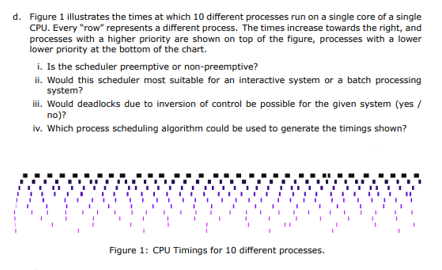d. Figure 1 illustrates the times at which 10 different processes run on a single core of a single CPU. Every "row" represents a different process. The times increase towards the right, and processes with a higher priority are shown on top of the figure, processes with a lower lower priority at the bottom of the chart. i. Is the scheduler preemptive or non-preemptive? i. Would this scheduler most suitable for an interactive system or a batch processing system? . Would deadlocks due to inversion of control be possible for the given system (yes / no)? iv. Which process scheduling algorithm could be used to generate the timings shown?
d. Figure 1 illustrates the times at which 10 different processes run on a single core of a single CPU. Every "row" represents a different process. The times increase towards the right, and processes with a higher priority are shown on top of the figure, processes with a lower lower priority at the bottom of the chart. i. Is the scheduler preemptive or non-preemptive? i. Would this scheduler most suitable for an interactive system or a batch processing system? . Would deadlocks due to inversion of control be possible for the given system (yes / no)? iv. Which process scheduling algorithm could be used to generate the timings shown?
Database System Concepts
7th Edition
ISBN:9780078022159
Author:Abraham Silberschatz Professor, Henry F. Korth, S. Sudarshan
Publisher:Abraham Silberschatz Professor, Henry F. Korth, S. Sudarshan
Chapter1: Introduction
Section: Chapter Questions
Problem 1PE
Related questions
Question
question (i)

Transcribed Image Text:d. Figure 1 illustrates the times at which 10 different processes run on a single core of a single
CPU. Every "row" represents a different process. The times increase towards the right, and
processes with a higher priority are shown on top of the figure, processes with a lower
lower priority at the bottom of the chart.
i. Is the scheduler preemptive or non-preemptive?
ii. Would this scheduler most suitable for an interactive system or a batch processing
system?
iii. Would deadlocks due to inversion of control be possible for the given system (yes /
no)?
iv. Which process scheduling algorithm could be used to generate the timings shown?
Figure 1: CPU Timings for 10 different processes.
Expert Solution
This question has been solved!
Explore an expertly crafted, step-by-step solution for a thorough understanding of key concepts.
Step by step
Solved in 2 steps

Knowledge Booster
Learn more about
Need a deep-dive on the concept behind this application? Look no further. Learn more about this topic, computer-science and related others by exploring similar questions and additional content below.Recommended textbooks for you

Database System Concepts
Computer Science
ISBN:
9780078022159
Author:
Abraham Silberschatz Professor, Henry F. Korth, S. Sudarshan
Publisher:
McGraw-Hill Education

Starting Out with Python (4th Edition)
Computer Science
ISBN:
9780134444321
Author:
Tony Gaddis
Publisher:
PEARSON

Digital Fundamentals (11th Edition)
Computer Science
ISBN:
9780132737968
Author:
Thomas L. Floyd
Publisher:
PEARSON

Database System Concepts
Computer Science
ISBN:
9780078022159
Author:
Abraham Silberschatz Professor, Henry F. Korth, S. Sudarshan
Publisher:
McGraw-Hill Education

Starting Out with Python (4th Edition)
Computer Science
ISBN:
9780134444321
Author:
Tony Gaddis
Publisher:
PEARSON

Digital Fundamentals (11th Edition)
Computer Science
ISBN:
9780132737968
Author:
Thomas L. Floyd
Publisher:
PEARSON

C How to Program (8th Edition)
Computer Science
ISBN:
9780133976892
Author:
Paul J. Deitel, Harvey Deitel
Publisher:
PEARSON

Database Systems: Design, Implementation, & Manag…
Computer Science
ISBN:
9781337627900
Author:
Carlos Coronel, Steven Morris
Publisher:
Cengage Learning

Programmable Logic Controllers
Computer Science
ISBN:
9780073373843
Author:
Frank D. Petruzella
Publisher:
McGraw-Hill Education